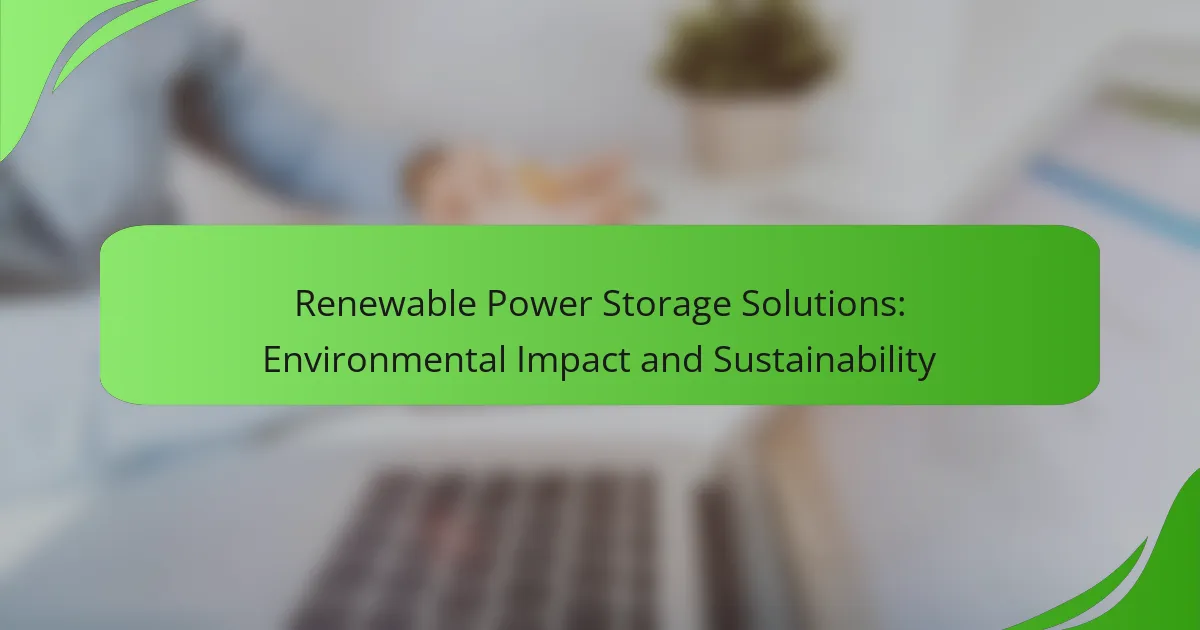Renewable power storage solutions play a crucial role in enhancing the sustainability of clean energy systems by optimizing energy use and reducing waste. Technologies such as lithium-ion batteries and pumped hydro storage enable efficient energy management, helping to balance supply and demand while minimizing reliance on fossil fuels. However, it is essential to consider the environmental impacts associated with the production and operation of these storage systems to ensure a truly sustainable energy future.
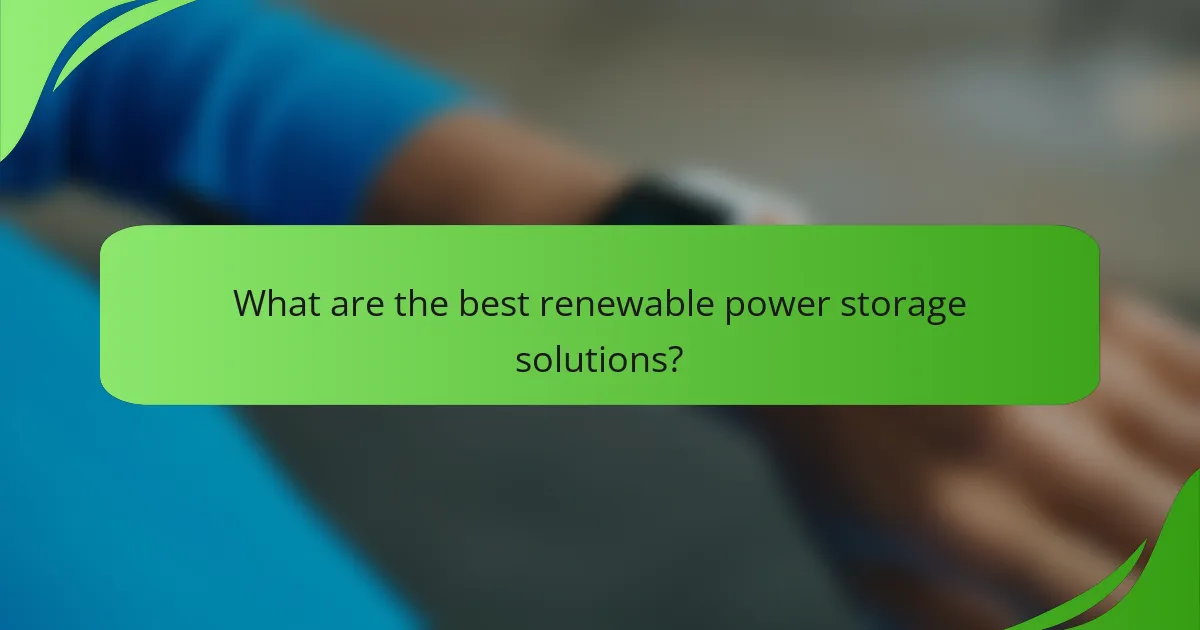
What are the best renewable power storage solutions?
The best renewable power storage solutions include lithium-ion batteries, pumped hydro storage, flywheel energy storage, compressed air energy storage, and solid-state batteries. Each of these technologies offers unique benefits and trade-offs, making them suitable for different applications in the renewable energy sector.
Lithium-ion batteries
Lithium-ion batteries are widely used for energy storage due to their high energy density and efficiency. They work by moving lithium ions between the anode and cathode during charging and discharging, allowing for rapid energy release and recharge cycles.
These batteries are commonly found in electric vehicles and grid storage applications. However, they can be costly and have environmental concerns related to lithium extraction and disposal.
Pumped hydro storage
Pumped hydro storage is a mature technology that uses two water reservoirs at different elevations. During low energy demand, excess electricity is used to pump water from the lower reservoir to the upper one. When demand increases, the stored water is released to generate electricity.
This method is highly efficient, with round-trip efficiencies often exceeding 70%. However, it requires significant geographical features and can have ecological impacts on local waterways.
Flywheel energy storage
Flywheel energy storage systems store energy in a rotating mass. When energy is added, the flywheel spins faster, storing kinetic energy. When energy is needed, the flywheel’s rotation is slowed down, converting kinetic energy back into electricity.
These systems are known for their rapid response times and long cycle life. However, they typically have lower energy density compared to batteries and are best suited for short-duration applications.
Compressed air energy storage
Compressed air energy storage (CAES) involves compressing air in underground caverns or tanks during periods of low energy demand. When energy is needed, the compressed air is heated and expanded to drive turbines and generate electricity.
CAES can store large amounts of energy and is suitable for long-duration storage. However, it requires specific geological formations and can have efficiency losses due to heat management.
Solid-state batteries
Solid-state batteries use a solid electrolyte instead of a liquid one, offering increased safety and energy density. They operate similarly to lithium-ion batteries but have the potential for higher performance and longer life cycles.
While still in development, solid-state batteries could revolutionize energy storage, especially in electric vehicles. However, they currently face challenges in manufacturing scalability and cost-effectiveness.
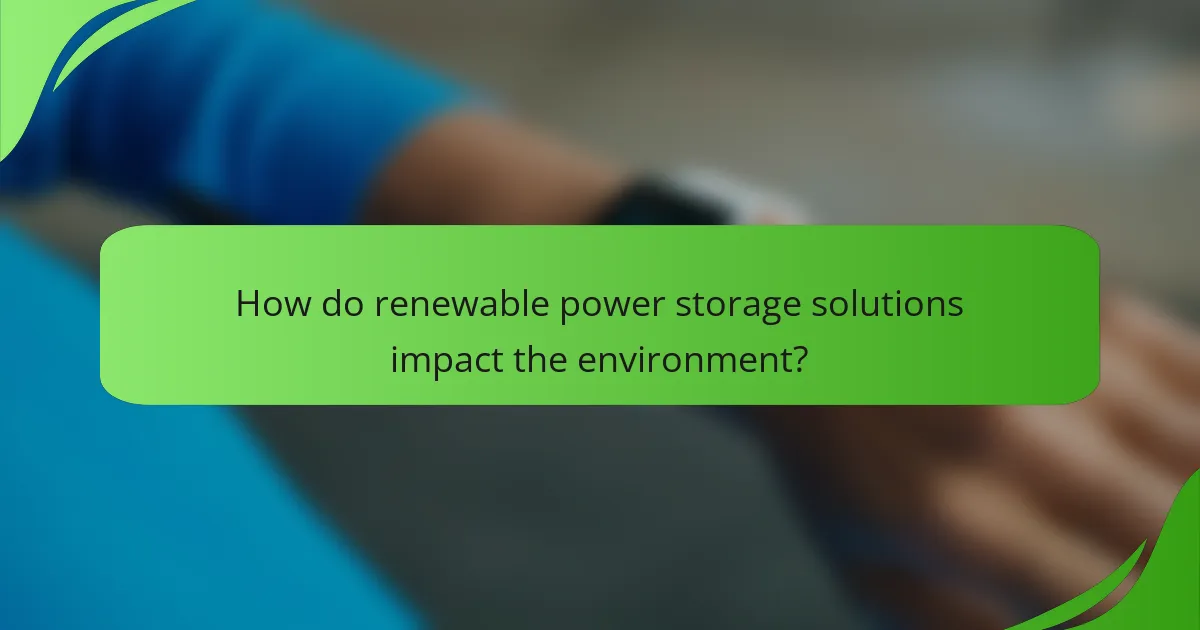
How do renewable power storage solutions impact the environment?
Renewable power storage solutions significantly influence the environment by enabling the efficient use of clean energy while minimizing negative effects. These systems help reduce reliance on fossil fuels, but their production and operation can have environmental consequences that need careful consideration.
Reduction of greenhouse gas emissions
Renewable power storage solutions, such as batteries and pumped hydro storage, play a crucial role in reducing greenhouse gas emissions. By storing excess energy generated from renewable sources like solar and wind, these systems allow for a more consistent energy supply, decreasing the need for fossil fuel-based power generation.
For instance, integrating large-scale battery storage can lead to a reduction in carbon emissions by enabling grid operators to use cleaner energy sources during peak demand. This shift can result in emissions reductions of anywhere from 20% to 50%, depending on the energy mix of the region.
Impact on land use
The deployment of renewable power storage solutions can have varying impacts on land use, particularly for large-scale installations. For example, utility-scale battery storage facilities may require significant land areas, which can lead to habitat disruption if not sited carefully.
Conversely, some storage solutions, like underground pumped hydro, minimize surface land use but may still affect local ecosystems. It is essential to evaluate land use impacts during the planning stages to ensure that storage solutions are implemented sustainably.
Water usage considerations
Water usage is an important factor when assessing the environmental impact of renewable power storage solutions. Technologies like pumped hydro storage require substantial amounts of water for operation, particularly for maintaining reservoir levels and ensuring efficient energy transfer.
In contrast, battery storage systems typically have minimal water requirements, making them a more sustainable option in water-scarce regions. Evaluating the water footprint of various storage technologies can guide decisions towards more environmentally friendly solutions, especially in areas facing water scarcity challenges.
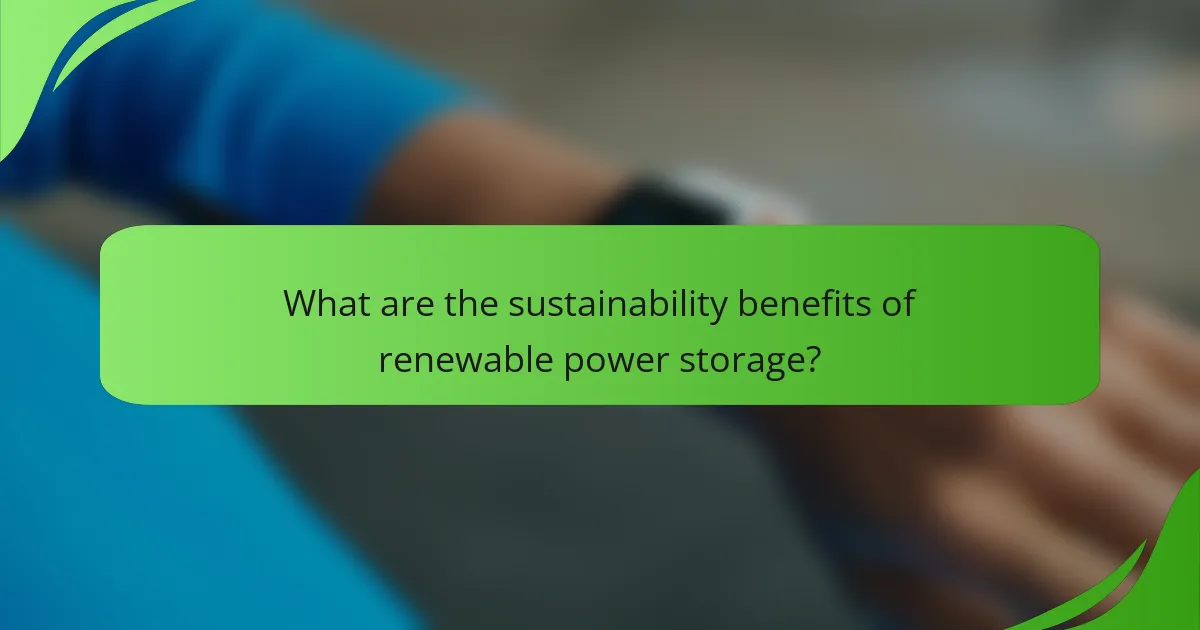
What are the sustainability benefits of renewable power storage?
Renewable power storage solutions significantly enhance sustainability by optimizing energy use, reducing waste, and supporting the integration of clean energy sources. These systems help balance supply and demand, leading to a more reliable and environmentally friendly energy grid.
Enhanced grid stability
Renewable power storage contributes to enhanced grid stability by providing backup energy during peak demand periods. This capability helps prevent blackouts and ensures a consistent power supply, particularly when renewable sources like solar and wind are intermittent.
For instance, battery storage systems can discharge energy during high consumption hours, stabilizing the grid and reducing reliance on fossil fuels. This stability is crucial for regions transitioning to a more renewable-based energy infrastructure.
Increased energy efficiency
Energy storage solutions improve overall energy efficiency by capturing excess energy generated during low demand and releasing it when needed. This process minimizes energy loss and maximizes the use of renewable resources.
For example, pumped hydro storage can store energy by moving water to higher elevations during surplus generation and releasing it to generate electricity during peak times. This method can achieve efficiencies of around 70-90%, making it a valuable tool for energy management.
Facilitation of renewable energy integration
Power storage systems facilitate the integration of renewable energy by providing a buffer that allows for a smoother transition between energy sources. This capability is essential for accommodating the variable nature of renewables.
By storing energy when production exceeds demand, these systems enable utilities to incorporate higher percentages of renewable sources into the grid. This transition not only supports sustainability goals but also helps meet regulatory requirements for reducing carbon emissions.

What factors should be considered when choosing a storage solution?
When selecting a renewable power storage solution, key factors include cost-effectiveness, scalability, environmental impact, and technology maturity. Each of these elements plays a crucial role in determining the overall viability and efficiency of the storage system.
Cost-effectiveness
Cost-effectiveness is essential when evaluating storage solutions, as it directly affects the overall investment and return on energy storage. Consider both initial capital costs and ongoing operational expenses, which can vary significantly between technologies like lithium-ion batteries, pumped hydro, and compressed air systems.
For example, while lithium-ion batteries may have higher upfront costs, their efficiency and longer lifespan can lead to lower costs over time. It’s important to calculate the levelized cost of storage (LCOS) to compare different options accurately.
Scalability
Scalability refers to the ability to expand the storage capacity as energy demands grow. A scalable solution allows for incremental investments, making it easier to adapt to changing energy needs without a complete overhaul of the system.
For instance, modular battery systems can be expanded by adding more units, while larger systems like pumped hydro may require significant infrastructure changes. Evaluate your current and future energy requirements to choose a solution that can grow with your needs.
Environmental impact
The environmental impact of a storage solution encompasses its lifecycle emissions, resource extraction, and end-of-life disposal. It’s crucial to assess how each technology affects the environment, from manufacturing to decommissioning.
For example, while lithium-ion batteries have a lower operational carbon footprint, the mining of lithium and cobalt can lead to significant ecological damage. Consider solutions that prioritize sustainability, such as those using recycled materials or renewable resources in their production.
Technology maturity
Technology maturity indicates how well-established and reliable a storage solution is. Mature technologies, like pumped hydro, have a proven track record and extensive operational data, while newer technologies may still be in the experimental phase.
Assessing the maturity of a technology helps in understanding potential risks and performance reliability. Look for solutions with demonstrated performance metrics and a history of successful implementation in various settings to minimize uncertainties in your investment.
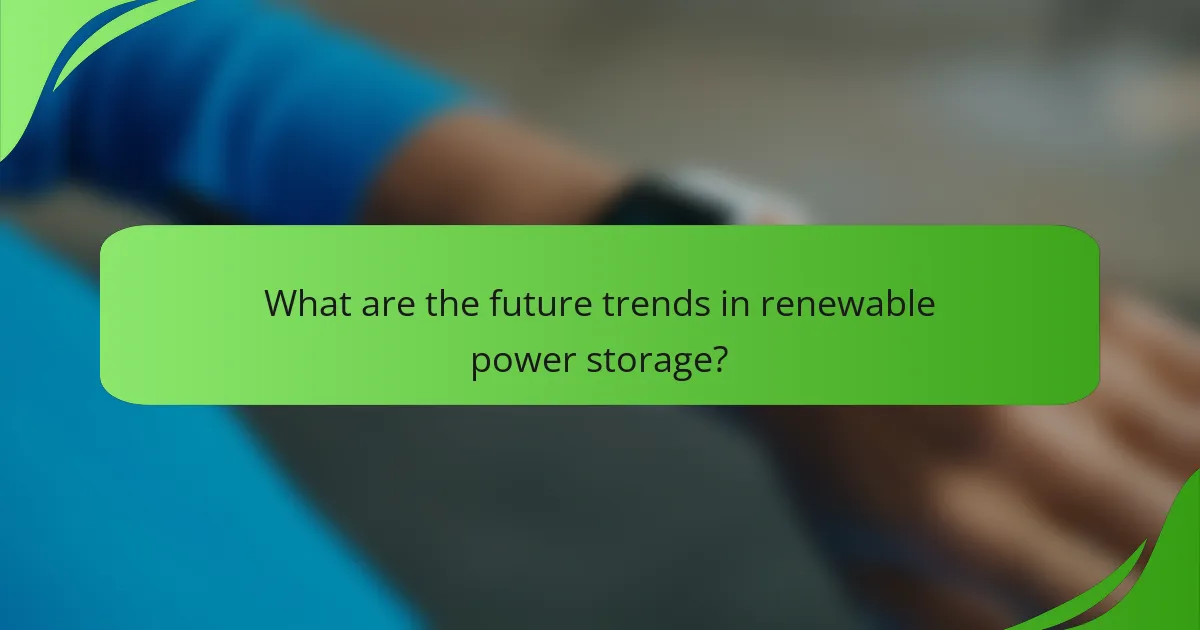
What are the future trends in renewable power storage?
Future trends in renewable power storage focus on improving efficiency, reducing costs, and enhancing integration with existing energy systems. Innovations in battery technology, smart grid integration, and the development of new materials are driving these advancements.
Advancements in battery technology
Battery technology is evolving rapidly, with significant improvements in energy density, lifespan, and charging speed. Lithium-ion batteries remain dominant, but alternatives like solid-state and flow batteries are gaining traction due to their potential for higher safety and efficiency.
For instance, solid-state batteries can offer energy densities exceeding 300 Wh/kg, which is substantially higher than traditional lithium-ion options. This advancement could lead to longer-lasting energy storage solutions for both residential and commercial applications.
Integration with smart grids
Smart grid technology enhances the management of energy resources by enabling real-time communication between energy producers and consumers. This integration allows for better demand response and load balancing, which is crucial for optimizing renewable energy use.
With smart grids, energy storage systems can be charged during low-demand periods and discharged when demand peaks, improving overall grid stability. This dynamic interaction can lead to cost savings and a more resilient energy infrastructure.
Emerging materials for energy storage
Research into new materials for energy storage is crucial for developing more efficient and sustainable solutions. Materials like graphene and sodium-ion are being explored as alternatives to traditional lithium-based systems, potentially offering lower costs and environmental impacts.
For example, sodium-ion batteries could be produced at a fraction of the cost of lithium-ion batteries, making them a viable option for large-scale energy storage. As these materials are further developed, they could significantly enhance the sustainability of renewable energy systems.
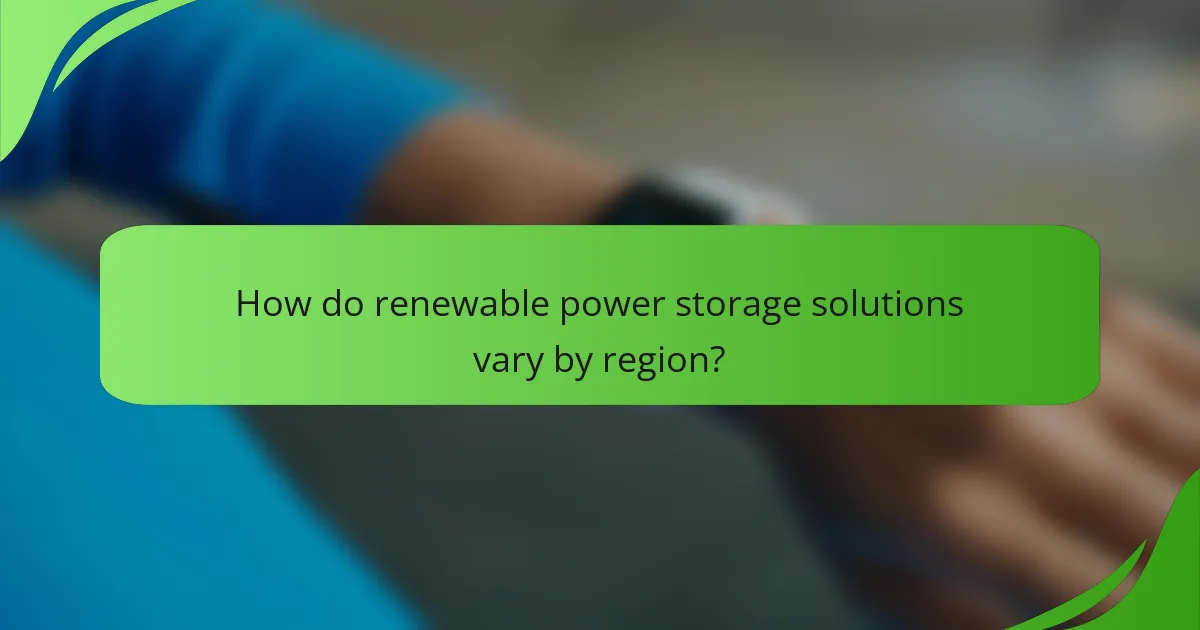
How do renewable power storage solutions vary by region?
Renewable power storage solutions differ significantly across regions due to variations in energy sources, technological advancements, and regulatory frameworks. These factors influence the types of storage systems adopted, their efficiency, and their environmental impact.
North America
In North America, particularly the United States and Canada, energy storage solutions primarily focus on lithium-ion batteries and pumped hydro storage. The vast geography and diverse energy mix allow for a variety of implementations, from residential solar battery systems to large-scale grid storage. Regulatory incentives, such as the Investment Tax Credit (ITC), further promote the adoption of these technologies.
Challenges include the environmental impact of lithium mining and the need for recycling programs to manage battery waste. As a result, many companies are exploring sustainable alternatives, such as flow batteries and advanced materials.
Europe
Europe showcases a strong emphasis on sustainability, with countries like Germany and Denmark leading in renewable energy storage. Here, solutions often include a combination of battery storage, thermal storage, and hydrogen production. The European Union’s Green Deal and various national policies encourage investment in innovative storage technologies.
One notable trend is the integration of energy storage with electric vehicle (EV) infrastructure, allowing for dual-use of batteries. However, regulatory hurdles and the need for grid upgrades can slow down implementation.
Asia
Asia, particularly China, is a global leader in renewable energy storage, focusing heavily on lithium-ion technology and emerging solutions like sodium-ion batteries. The rapid expansion of solar and wind energy in the region has driven demand for efficient storage systems to balance supply and demand.
Government policies, such as subsidies and research funding, support the development of advanced storage technologies. However, concerns about the environmental impact of battery production and disposal remain significant, prompting research into more sustainable options.
Australia
Australia’s renewable power storage solutions are heavily influenced by its abundant solar resources. Homeowners and businesses increasingly adopt battery storage systems to maximize solar energy use. The National Electricity Market (NEM) supports various storage technologies, including lithium-ion and pumped hydro.
Despite the growth, challenges include high upfront costs and the need for better grid integration. Programs like the Solar Homes Program aim to alleviate these issues by providing financial incentives for battery installations.
